CONTEXT AND SIGNIFICANCE
Our previous research became an inspiration for our proposal. When people see something, they tend to guess what the device is going to do when they perform certain actions. Similarly, the audience looking at our project would have guessed what will happen to them when they perform certain action. Looking at the slot machine looking object, they would immediately guess that the slot machine just would be a slot machine. For our case, because it says “Roll 3 white rabbits to win a candy”, the audience will just think that it is just a candy giving slot machine. However, the uniqueness of our project is that, because the slot machine would rather spit out the candy looking message (usually they did not even know that it is not a candy until they pilled the wrap off). Looking at the message expecting a candy, the audience will feel the emptiness that would be similar to the one that gambling will give to people. Because our intent is to make people avoid gambling and the audience that we performed in front was students, the coin inside the slot machine was replaced with the candy.
CONCEPTION AND DESIGN
There is not much design, because we were attempting to resemble the slot machine.

As you can see, our device is built out of the wood in the fabrication room, paint, papers, and other Arduino related devices.
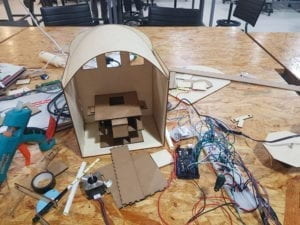
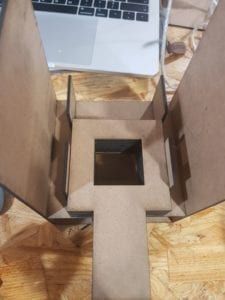
Because the wheel has to rotate, our intent was to make the structure steady enough so that the device can be firm for the wheel to rotate. However, because it was made out of wood which was fabricated, if our measurement was off, we could not really replace it. Therefore it was difficult for us to put the things together. Especially, because we were running out of time for the third motor in the middle and because we had to have a hole in the middle for putting the candy inside, we decided to make the stand (for the step motor) out of leftover wood and rubber band. Maybe next time, it would be better for us to think of the better way to spit out candy.
In addition, maybe we should have used the steel for holding the hole (for rotation of the bar) because the machine definitely was having difficulty rotating properly since the plastic that was used to put inside the hole would wabble once in a while prohibiting the rotation to work properly.
For the 3 rabbit part, we changed the material from the 8-segmented LED to the 3 stepper motor because of the size difficulty (when the device would be huge, the 8-segmented LEDs were too small) and to resemble more closely to the real slot machine.
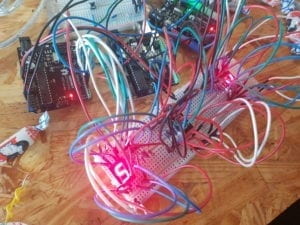
Instead of the 3 rabbits on the roll, our initial intent was to do go for 3 7’s. Therefore, the code would generate random numbers for each of 3 LEDs showing the number on the screen every time the button is pressed. However, we decided to change the 8-segmented LED to the 3 stepper motor because of the size (when the device would be huge, the 8-segmented LEDs were too small) and to resemble more closely to the real slot machine.
FABRICATION AND PRODUCTION:
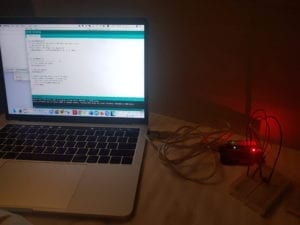 The number one step that I did was to do the basic coding without connecting any device to the Arduino. (Such as randomSeed the number for all 3 step motors)
The number one step that I did was to do the basic coding without connecting any device to the Arduino. (Such as randomSeed the number for all 3 step motors)
Because this allows my creativity to happen, it was more easy for me to write the code. It was, then easier for me to figure out the rest because I only had to do the coding related to 8-segmented LED (initially. It was after the user test that we changed the LED to the step motors).
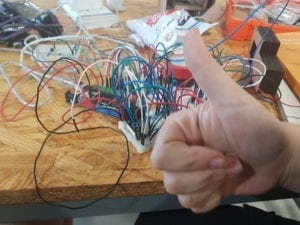


After that, we did the user testing because we had to test the users’ reaction to the statements or whether the statement would actually work. Because our device was deviating slightly from the real slot machine in a way that our project would spit out candy not coins, we asked the users questions like “Do you think the idea of candy is better? Should we just stick with the coin?” and looked at the user’s reaction when they were unwrapping the candy. During the User Testing Session, we got some meaningful advice listed below.
- Rather than using 3 Arduino Unos, just use 1 Arduino Mega, because it is difficult for us to do the connection between 3 Arduino Unos.
- If we were to use the coin, laser cut the coins (with the message on). When the user is winning the coin, make A LOT OF COINS to fall down, just like a slot machine.
- Would the actuator be powerful enough?
- Use the lever rather than a button.
- Win now or go for more buttons (2 choices)? (The gambling idea)
- Suspense (time in between number rolls)
- Candy or coin? -> depends on the audience
After receiving above feedback, we were reinforced by our white rabbit candy idea (because it was even difficult for us to differentiate the fake candies from the real candies) since the main audience of ours was our classmates or other college students (who started to have access to the gambling place). In addition, we changed the 3 Arduino Unos to 1 Arduino Mega, and added the suspense by putting some time and MORE ROLLS (the stepper is made to make 4 rolls before it actually stops on the right value) in between each roll.

Also, because we realized that our initial idea of the servo pushing out the candy would not be enough, we decided to add the 4th step motor to become the actuator. Above is the sketch that I made in order to build the actuator for the candy machine. By making this actuator to work, it was easier for us to move the bar to move out one candy from the group.
In addition, because we had to change from the 8 segment LED to the step motor, we also had to work out the code with the stepper motor. (Using the map function, the amount of degree that the stepper has to do was calculated).
However, because one of the motor would fail to stop at the right value until the end, we had to remove the randomSeed and made the project to show the white rabbit every single time the user pressed the button.
Below is our finalized project with the Code.
CONCLUSIONS
The goal of our project was to give an emptiness that is similar to the feeling that the gambler would feel after gambling and make the users avoid gambling especially because the college students are at the age when they start to have access to gambling places. Our project align with my definition of interaction in a way that it is obvious that a project is a slot machine. However, our project definitely failed to interact with the user because we did not have time to switch the small button to the big arcade button (we were panicking at the end because one of our wheels would not function well).
However, in a way that the audience was surprised by the fact that the object inside the candy wrap was not a real candy but was a paper with the message on. It was almost a failure if the audience who decided to perform decided not to eat the candy in that place. Maybe next time, we would have to think about a more direct way because some people may hate sweets and decide not to eat on that spot. This project experience would be essential in order to create a better, final project that is more interactive enough (something that the user can tell right away of the usage) and that functions better.